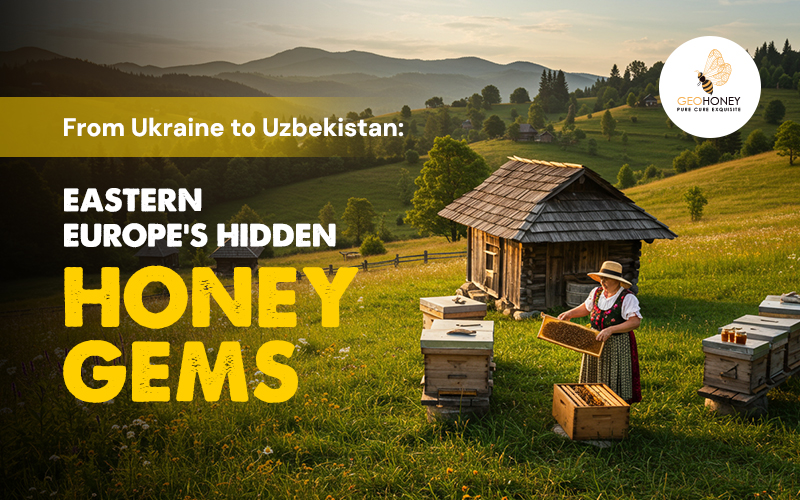- Tokyo: 21:09
- Singapore: 20:09
- Dubai: 16:09
- London: 12:09
- New York: 07:09
From Ukraine to Uzbekistan: Eastern Europe's Hidden Honey Gems

Eastern Europe is a region that is known for its historic cities, unparalleled architecture, and diverse landscapes that feature sunflower fields, desert blooms, mesmerizing mountains, steppes, and valleys.
However, there is another really incredible but less talked about treasure that this vast region has to offer. We are talking about organic raw honey that has been a staple in Eastern European medicinal and culinary fabric for centuries.
“Eastern European honey is not a mere sweetener. It is a symbol of local tradition, culture, biodiversity, purity, and ancient craftsmanship that is passed down through generations.”, says the founder of Geohoney and the CEO of B A Barry Group, Mr Basem Barry.
This blog takes you on an incredible journey into the heart of Eastern Europe, from the wildflower and sunflower fields of Ukraine to the mountainous regions of Georgia to the arid plains of Uzbekistan, exploring the hidden honey gems that these countries have to offer. So, keep on reading till the end.
Ukraine - Acacia Honey
Poland – Black Forest Honey
Bulgaria – Lavender Honey
Georgia – Chestnut Honey
Serbia – Wild Flower Honey
Uzbekistan – Desert Herb Honey
Ukraine - Acacia Honey
Ukraine is among the largest producers of honey in Eastern Europe. This region features diverse flora, including huge wildflower meadows and buckwheat fields. However, the country is mainly known for its endless Acacia groves and the acacia honey that comes from them.
Ukraine offers an ideal climate for bees to gather nectar. The beekeepers in the region use traditional honey harvesting methods, which ensure both high quality and yield.
Beekeeping is so common in Ukraine that you can even find local roadside vendors selling jars of pure honey in the regions of Vinnytsia, Poltava, and Zaporizhzhia.
Key Features of Ukraine’s Acacia Honey
This honey comes in a very light and almost clear to golden colors.
It has a high fructose content, which reduces its crystallization rate.
Acacia honey has a light floral flavor and aroma. Its mostly neutral flavor makes it ideal for countless culinary applications.
This honey is rich in antioxidants like flavonoids, chrysin, and phenols.
It is also a rich source of Vitamins A, B6, and C, and minerals like calcium and magnesium.
Poland – Black Forest Honey
Beekeeping has been a significant part of the culture in Poland, where natives have been raising wild forest bees since medieval times. Regions like Podlasie and Mazury in Poland still practice traditional beekeeping to create medicinal honey varieties that are mixed with royal jelly and propolis to enhance their effectiveness.
This region is mainly known to produce natural and raw black forest honey that features a very robust flavor and an impressive nutritional profile.
Key Features of Poland’s Black Forest Honey
This honey has a high mineral content, which imparts a rich brownish or dark amber to black hue to it.
This honey has a complex flavor profile, which mainly depends on the type of flora that bees forage in the forests. It contains less sweet, herbal, earthy, woody, and malty notes.
This honey has a smooth and moderately thick consistency.
Black forest honey is rich in carbohydrates, antioxidants, and minerals, which give it super anti-inflammatory, antibacterial, and immune-boosting properties.
Bulgaria – Lavender Honey
When talking about Bulgaria, most people immediately think about its massive rose oil industry. However, this region is also known to produce premium-quality honey. Bulgarian honey is made in perfect conditions, which are a combination of abundant herbs, temperate climate, and pristine air.
This region mainly produces high-quality lavender honey, which is a nutrient-dense natural sweetener that gives you both an amazing taste and countless health benefits.
Key Features of Bulgaria’s Lavender Honey
The color of this honey can be described as white, extra clear, or pale amber.
Lavender honey has a sweet, mild, and floral flavor.
This honey is known for its low acidity and less bitter aftertaste.
This honey crystallizes quickly and turns into fine granules of a light brown color.
This honey is a rich source of calories and carbohydrates.
It is effective for reducing stress, strengthening the immune system, and promoting better health of your respiratory system.
Georgia – Chestnut Honey
This is another key region in Eastern Europe that produces pure, raw honey. Beekeeping is a truly ancient aspect of the culture in the region. So much so that archaeologists have unearthed hives that date back thousands of years in this area.
The Kakheti, Adjara, and Svaneti areas are particularly notable, where local beekeepers have been practicing this art for centuries. Georgia is particularly famous for its chestnut honey, which has countless culinary and medicinal uses. This is a relatively less sweet honey variety that can amplify any recipe without altering its original flavor.
Key Features of Georgia’s Chestnut Honey
It comes in deep amber, dark brown, and almost black colors.
This honey has a strong woody or bitter flavor with notes of smoke, licorice, or tannins in some cases.
Its high fructose content slows down its crystallization rate. It crystallizes after one to two years once you open the jar.
This mineral and nutrient-rich substance promotes wound healing, skin health, immune support, and digestive health.
This honey has a smooth, flowy, or runny texture.
Serbia – Wild Flower Honey
Beekeeping holds special significance in Siberian culture. Monks in Siberia’s ancient monasteries in regions like Fruska Gora practice age-old apiary and honey harvesting practices to this very day.
This region also stands out for its contributions to apitherapy, which is a field that deals with using honey to promote healing and well-being.
This region produces the purest wild flower honey, whose every jar gives you a unique flavor and countless nutrients. This honey possesses superior antibacterial and antiviral features, which promote better digestion, quicker wound healing, and seasonal allergy prevention.
Key Features of Siberia’s Wildflower Honey
This honey possesses a light amber, pale yellow, or even dark amber hue based on the wildflower nectar sources.
Each batch of this honey has a unique flavor with balanced sweetness and distinct floral, herbal, woody, or spicy undertones.
This honey has a very thick but easily spreadable consistency.
Wildflower honey also contains beneficial enzymes, amino acids, B vitamins, and minerals like zinc, iron, magnesium, and potassium.
Uzbekistan – Desert Herb Honey
This is another notable region where beekeeping is still thriving. Areas like the Fergana Valley, Tashkent, and Samarkand stand out for beekeeping activities in Uzbekistan. These areas feature exotic desserts and oasis flora, and a dry climate that is ideal for making exquisite organic honey varieties.
This region produces the unique desert herb honey, which is used in green and black teas or mixed with dried fruits and nuts.
Key Features of Uzbekistan’s Desert Herb Honey
This honey features a smooth golden to light amber hue.
Desert Herb honey has a rich, earthy flavor with very subtle floral notes.
This honey has a smooth but less viscous consistency.
This honey is prone to crystallization with changing seasons.
It contains several health-promoting compounds like antioxidants, micronutrients, healthy enzymes, etc.
Conclusion
There are many exotic and unique hidden honey gems that you can find all over the Eastern European region. Countries like Ukraine, Poland, Serbia, all the way to Bulgaria and Uzbekistan, offer you honey varieties that reflect the region’s natural and traditional beauty.
The Eastern European honey is known for its exceptional purity, which arises from its age-old and sustainable beekeeping practices and minimal processing.
So, the next time you wish to try out some unique, flavorful, and pure honey varieties, we suggest you look for Eastern European honey to experience something really extraordinary with every single spoonful that you consume.
You can visit us at Geohoney to check out our wide range of monofloral honey varieties sourced from skilled beekeepers from all over the globe.



